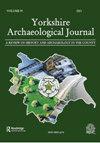Medieval hemp retting? Excavations at Bridge Lane House, Bawtry, Doncaster
IF 0.2
0 ARCHAEOLOGY
引用次数: 1
Abstract
In 2012, Wessex Archaeology was commissioned by Rural Estates Limited to complete reporting on excavations previously undertaken in 2006–2007 by ARCUS (University of Sheffield) for Lewis Holdings Limited. The excavations, located off Gainsborough Road, Bawtry at Grid Reference SK 653 928, had been carried out ahead of residential development on a small irregular infill plot between existing houses and a pub (Figure 1). This summary is taken from the full report on the results of the investigations. Although the earliest archaeological features were Medieval, residual late Mesolithic or Early Neolithic flint blades and abraded Roman pottery were recovered from later contexts, indicating the potential for earlier activity in the vicinity of the site. The earliest archaeological features on site included a series of sub-rectangular ponds (213, 389, 410, and 419) the largest of which (389) was at least 10 m long by 6.7 m wide and greater than 1.2 m deep (Figure 1). One of the ponds (419) contained a wooden revetment dendrochronologically dated to the thirteenth century (Tyers 2012). Two circular pits also belonged to the first phase, one of which was barrel-lined with oak planks (358) although the other (362) did not retain a wooden lining. Both pits had similar dimensions and profiles; pit 358 was 0.96 m deep, 2.3 m wide at the top with a shallow shelf leading to the central, barrel-lined shaft 0.7 m wide. A series of deposits filled the pits which produced pottery suggesting a thirteenth century date. Also belonging to this initial phase of activity were pit 415 and a ditch (413) extending east from Church Street, the latter likely to represent a boundary between two plots of land (both of which contained ponds). Evaluation trench 2 in the east of the site exposed a further large pond (213), which is likely to have been open for some time (Figure 1). Environmental evidence from this pond suggests nearby disturbed ground, damp ground, stagnant water, hedgerows and human habitation, with nitrogen enrichment of the soil indicated (Simmons 2012). Small numbers of hemp (Cannabis sativa) seeds were present. Hemp was widely cultivated in the region in the Medieval period for use in the manufacture of rope, canvas, paper, and oil up until the nineteenth century when the industry collapsed due to cheap imports. The proximity of the site to the River Idle and wharf may indicate that hemp was being grown and processed to make ropes or canvas for river traffic. The ideal hemp retting pit is described in Bradshaw et al. (1981) as ‘a small deep pond unconnected to the local water supply’. This was because the process of retting the hemp stems would contaminate water and smell unpleasant. The中世纪的麻屑?唐卡斯特巴特里桥巷住宅的挖掘
2012年,威塞克斯考古受乡村地产有限公司委托,完成了此前由谢菲尔德大学(ARCUS)为刘易斯控股有限公司(Lewis Holdings Limited)于2006-2007年进行的挖掘报告。挖掘位于Gainsborough Road, batry, Grid Reference SK 653 928,在住宅开发之前,在现有房屋和酒吧之间的一个小型不规则填充地块上进行(图1)。这是调查结果的完整报告。虽然最早的考古特征是中世纪的,但在后来的环境中发现了残留的中石器时代晚期或新石器时代早期的燧石刀片和磨损的罗马陶器,这表明该遗址附近可能有更早的活动。现场最早的考古特征包括一系列亚矩形池塘(213、389、410和419),其中最大的(389)至少长10米,宽6.7米,深超过1.2米(图1)。其中一个池塘(419)包含一个木制护岸,其年代可追溯到13世纪(Tyers 2012)。两个圆形坑也属于第一阶段,其中一个用橡木板(358)内衬,而另一个(362)没有保留木衬里。两个坑具有相似的尺寸和轮廓;358号坑深0.96米,顶部宽2.3米,一个浅架子通向中央,桶内衬的竖井宽0.7米。一系列沉积物填满了这些坑,这些坑里的陶器表明它们的年代是13世纪。同样属于这个初始阶段的还有415号坑和一条从教堂街向东延伸的沟渠(413),后者可能代表了两块土地之间的边界(两者都包含池塘)。在遗址东部的评估沟2暴露了另一个大池塘(213),该池塘可能已经开放了一段时间(图1)。来自该池塘的环境证据表明,附近有扰动地面、潮湿地面、死水、树篱和人类居住,并表明土壤富含氮(Simmons 2012)。少量的大麻(大麻sativa)种子存在。在中世纪时期,大麻在该地区被广泛种植,用于制造绳索、帆布、纸张和石油,直到19世纪,由于廉价的进口,该工业崩溃。该遗址靠近Idle河和码头,这可能表明大麻正在被种植和加工,以制造用于河流交通的绳索或帆布。布拉德肖等人(1981)将理想的大麻蒸馏坑描述为“与当地供水无关的小深池”。这是因为将大麻茎烘干的过程会污染水,而且气味难闻。的
本文章由计算机程序翻译,如有差异,请以英文原文为准。
求助全文
约1分钟内获得全文
求助全文

 求助内容:
求助内容: 应助结果提醒方式:
应助结果提醒方式:


